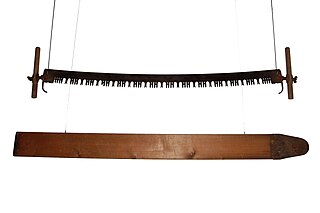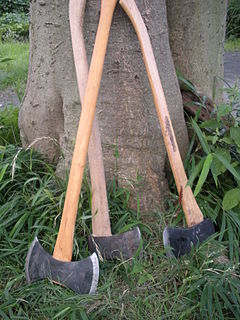
The bark spud (also known as a peeling iron, peeler bar, peeling spud, or abbreviated to spud) is an implement which is used to remove bark from felled timber. [1] [2]

The bark spud (also known as a peeling iron, peeler bar, peeling spud, or abbreviated to spud) is an implement which is used to remove bark from felled timber. [1] [2]
Most bark spuds have steel heads and wooden handles, typically hickory or ash. The head is curved, sometimes in one direction with a single cutting edge, and sometimes more dish shaped and sharpened on three sides.
In use, the sharpened edge is slid between the bark and the wood, removing the bark from the tree in a number of strips. It is especially useful at removing bark without damaging the wood below the bark. [3]
A coa de jima is a similar specialized tool for harvesting agaves. The drawknife also removes bark from felled trees.

A chisel is a tool with a characteristically shaped cutting edge of blade on its end, for carving or cutting a hard material such as wood, stone, or metal by hand, struck with a mallet, or mechanical power. The handle and blade of some types of chisel are made of metal or of wood with a sharp edge in it.

Wood carving is a form of woodworking by means of a cutting tool (knife) in one hand or a chisel by two hands or with one hand on a chisel and one hand on a mallet, resulting in a wooden figure or figurine, or in the sculptural ornamentation of a wooden object. The phrase may also refer to the finished product, from individual sculptures to hand-worked mouldings composing part of a tracery.

A blade is the portion of a tool, weapon, or machine with an edge that is designed to puncture, chop, slice or scrape surfaces or materials. Blades are typically made from materials that are harder than those they are to be used on. Historically, humans have made blades from flaking stones such as flint or obsidian, and from various metal such as copper, bronze and iron. Modern blades are often made of steel or ceramic. Blades are one of humanity's oldest tools, and continue to be used for combat, food preparation, and other purposes.

Drills are cutting tools used to remove material to create holes, almost always of circular cross-section. Drills come in many sizes and shapes and can create different kinds of holes in many different materials. In order to create holes drill bits are usually attached to a drill, which powers them to cut through the workpiece, typically by rotation. The drill will grasp the upper end of a bit called the shank in the chuck.

Thuja plicata is an evergreen coniferous tree in the cypress family Cupressaceae, native to western North America. Its common name is western redcedar, and it is also called Pacific redcedar, giant arborvitae, western arborvitae, just cedar, giant cedar, or shinglewood. It is not a true cedar of the genus Cedrus.

A pencil sharpener is a tool for sharpening a pencil's writing point by shaving away its worn surface. Pencil sharpeners may be operated manually or by an electric motor. It is common for many sharpeners to have a casing around them, which can be removed for emptying the pencil shavings debris into a bin.

Woodturning is the craft of using a wood lathe with hand-held tools to cut a shape that is symmetrical around the axis of rotation. Like the potter's wheel, the wood lathe is a simple mechanism that can generate a variety of forms. The operator is known as a turner, and the skills needed to use the tools were traditionally known as turnery. In pre-industrial England, these skills were sufficiently difficult to be known as 'the misterie' of the turners guild. The skills to use the tools by hand, without a fixed point of contact with the wood, distinguish woodturning and the wood lathe from the machinist's lathe, or metal-working lathe.

A crosscut saw is any saw designed for cutting wood perpendicular to (across) the wood grain. Crosscut saws may be small or large, with small teeth close together for fine work like woodworking or large for coarse work like log bucking, and can be a hand tool or power tool.

Betula lenta is a species of birch native to eastern North America, from southern Maine west to southernmost Ontario, and south in the Appalachian Mountains to northern Georgia.

A kitchen knife is any knife that is intended to be used in food preparation. While much of this work can be accomplished with a few general-purpose knives – notably a large chef's knife, a tough cleaver, a small paring knife and some sort of serrated blade – there are also many specialized knives that are designed for specific tasks. Kitchen knives can be made from several different materials.

A billhook or bill hook, also called a pruning knife or spar hook, is a versatile cutting tool used widely in agriculture and forestry for cutting woody material such as shrubs, small trees and branches. It is distinct from the sickle. It was commonly used in Europe with an important variety of traditional local patterns. Elsewhere, it was also developed locally such as in the Indian subcontinent, or introduced regionally as in the Americas, South Africa and Oceania by European settlers.

Sharpening stones, or whetstones, are used to sharpen the edges of steel tools such as knives through grinding and honing.

Sharpening is the process of creating or refining 2 perpendicular axis into a converging "Apex" creating an edge of appropriate shape on a tool or implement designed for cutting. Sharpening is done by removing material on an implement with an abrasive substance harder than the material of the implement, followed sometimes by processes to polish/hone the sharp surface to increase smoothness.

Knife sharpening is the process of making a knife or similar tool sharp by grinding against a hard, rough surface, typically a stone, or a flexible surface with hard particles, such as sandpaper. Additionally, a leather razor strop, or strop, is often used to straighten and polish an edge.
This glossary of woodworking lists a number of specialized terms and concepts used in woodworking, carpentry, and related disciplines.

A digging bar is a long, straight metal bar used for various purposes, including as a post hole digger, to break up or loosen hard or compacted materials such as soil, rock, concrete and ice or as a lever to move objects. Known by other names depending on locale, structural features and intended purpose such as a hop bar or crowbar in Britain, Australia and New Zealand, and slate bar, shale bar, spud bar, pinch point bar or San Angelo bar in North America, or just a bar. In Hawaii, a similar, traditional wooden device known as an ‘o‘o stick is used as a digging bar in groundbreaking ceremonies. Not to be confused with a curved crowbar, which is designed to provide leverage rather than to dig.

A stem is one of two main structural axes of a vascular plant, the other being the root. It supports leaves, flowers and fruits, transports water and dissolved substances between the roots and the shoots in the xylem and phloem, stores nutrients, and produces new living tissue.

An axe is an implement that has been used for millennia to shape, split and cut wood, to harvest timber, as a weapon, and as a ceremonial or heraldic symbol. The axe has many forms and specialised uses but generally consists of an axe head with a handle, or helve.

Frost crack or Southwest canker is a form of tree bark damage sometimes found on thin barked trees, visible as vertical fractures on the southerly facing surfaces of tree trunks. Frost crack is distinct from sun scald and sun crack and physically differs from normal rough-bark characteristics as seen in mature oaks, pines, poplars and other tree species.